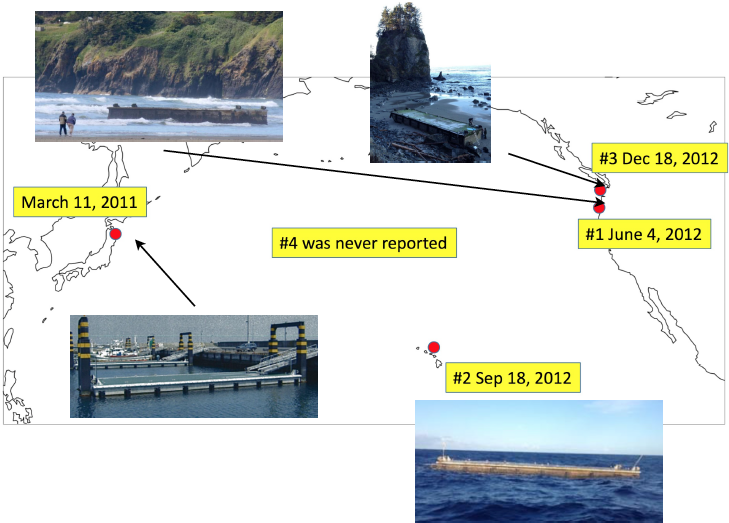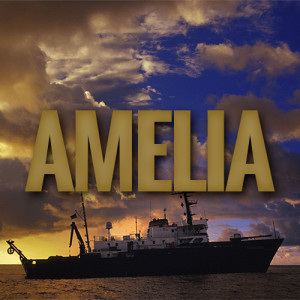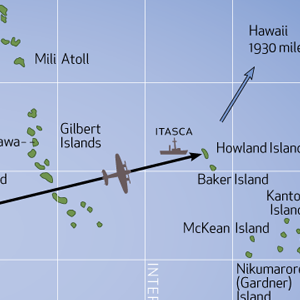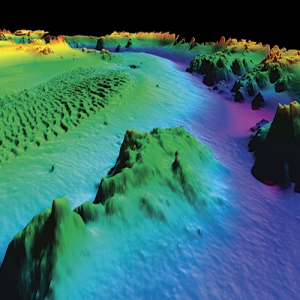Central Pacific Edition
WANTED: Wet or Dry
The Floating Dock that Eluded Capture in the Pacific for 6 Years
On March 11, 2011, an earthquake in Japan registering 9.0 on the Richter Scale shook the world. A tsunami event was generated sending walls of water over jetties and levees into seaside towns and villages along the Japanese coast. The toll of death and destruction was devastating. Officially over 15,893 persons killed, 6,152 injured and 2,567 missing. Property losses were enormous . The Japanese Ministry of Environment estimated that 4.8 million tons of tsunami debris washed into the North Pacific; 68 percent sank and 32 percent remained adrift.
The city of Misawa Japan lost four sections of its steel floating dock each 60 feet in length. Three of these sections were later found in 2012 on the shores of Hawaii, Washington and Oregon. There is one that remains undetected. It is suspected to be in the Central Pacific region in an area near the Republic of Marshall Islands. You’re right if that’s where you think we’re going next. If it is found, researchers want to tag it to that it can be tracked and eventually captured for scientific study. Alan Eustace, who will be joining us in a few days, will be bringing satellite tracking devices for this purpose. So if we encounter this runaway, we are equipped to tag it and bag it.
 Researchers have already found about 70 species of seaweeds and 240 species of invertebrates and microorganisms living on debris, primarily along Washington and Oregon where most of the work is concentrated. Some of the species are known only from Asia, especially Japan; some naturally occur on both sides of the Pacific; some were previously introduced to North America; some are non-native to Japan; others require more study. Scientists appreciate that even one invader has the potential to cause serious environmental and economic harm. Yet history also shows that most exotics coexist with native species without becoming pests, at least in the short term. Identifying potential insurgents is the daunting challenge, given the continent’s vast, corrugated coastline and the certainty of more debris yet to come.
Researchers have already found about 70 species of seaweeds and 240 species of invertebrates and microorganisms living on debris, primarily along Washington and Oregon where most of the work is concentrated. Some of the species are known only from Asia, especially Japan; some naturally occur on both sides of the Pacific; some were previously introduced to North America; some are non-native to Japan; others require more study. Scientists appreciate that even one invader has the potential to cause serious environmental and economic harm. Yet history also shows that most exotics coexist with native species without becoming pests, at least in the short term. Identifying potential insurgents is the daunting challenge, given the continent’s vast, corrugated coastline and the certainty of more debris yet to come.
What is Meridian Passages?
For our search expeditions, Spence suggested that we have a daily ship’s “newspaper,” seeing it as a good way to promulgate details of the ship’s schedule (the Plan of the Day). We saw it as a fun way to get people on the ship involved with each other, to help document the experience, and provide some working material for the Education Team. Thus was born Meridian Passages, Central Pacific Edition.
Passages was a newsletter we had been publishing at Nauticos since 1997, starting back when our company operated under the name Meridian Sciences, Inc. I coined the title Meridian Passages as sort of a triple pun. Our company name was Meridian; a passage is a story, and a meridian passage is the passing of a heavenly body (like the sun, moon, or a star) across one’s meridian of longitude. Hence, the meridian passage of the sun is another name for “noon,” and it is the moment when a body is highest in the sky. The astronomical reference appealed to me, as an amateur astronomer operating a company whose specialties included the science of navigation.
So, the first edition of Volume XIII of Meridian Passages was issued on the day after we got under way. It features news of the day, the official Plan of the Day, a Spotlight on a crew member, a story or article, and a mock “Classifieds” section for fun.
Anyone can contribute, but we rely heavily on Reporter Marika for interviews, Teacher Sallie for SEA School, Photographer Sue for images, Spence for Plan of the Day, Joe for sea stories, and Bethany for layout. They and others have contributed articles and ideas for Classifieds. Of course, whatever happens out here is raw material.
Our first issue was received with raised eyebrows and puzzled looks. But after a few days, folks would come looking if we didn’t roll the presses by our self-imposed deadline.
— Editor.



